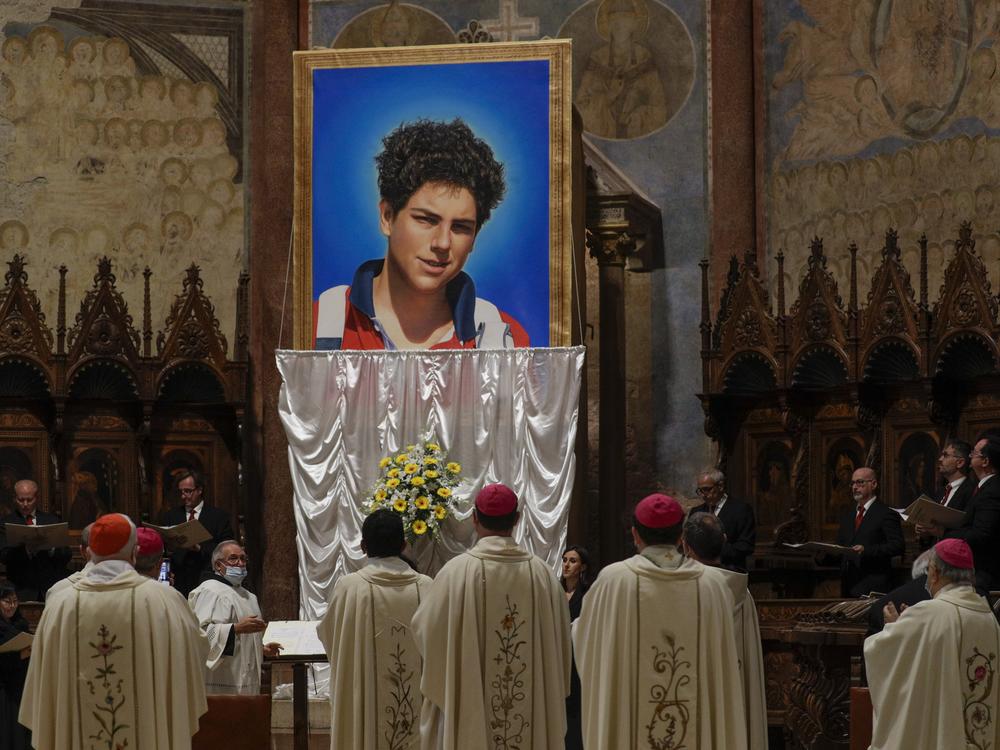Section Branding
Header Content
A teen tech whiz nicknamed 'God's influencer' will become the first millennial saint
Primary Content
A teenage computer whiz who used the early-aughts internet to spread awareness of the Catholic faith will become the church's first millennial saint.
Carlo Acutis, who died of leukemia at age 15 in 2006, is already referred to as "God's influencer" and the "patron saint of the internet" for his work cataloging Eucharistic miracles around the world — and soon it will be official.
Pope Francis and a group of cardinals approved Acutis for canonization at a meeting at the Vatican on Monday, Vatican News announced. It says he will likely be proclaimed a saint at some point in 2025, during the church's jubilee year.
Acutis was a devout Catholic who taught himself programming from an early age and created websites with a spiritual focus, including his widely praised database of miracles. He is credited with helping homeless people and defending victims of bullying during his lifetime, and having a hand in two healing miracles after his death — the requisite number for all Catholic saints.
Monday's approval clears the final hurdle in a multiyear process, which began in 2013 when the pope approved the cause for his beatification and canonization and named him "a Servant of God."
There are three steps to becoming a saint in the Catholic Church.
First, the pope must declare a deceased person "Venerable," a formal recognition that they lived a heroically virtuous life. In order to be beatified — and recognized as "Blessed"— they must have taken part in a miracle, which is usually one of healing. Canonization requires a second miracle after beatification.
Acutis was beatified in October 2020, after the Vatican officially recognized that he interceded from heaven in 2013 to save the life of a Brazilian child who was suffering from a rare pancreatic condition. The Vatican said 4-year-old Matheus Vianna was healed after praying to Acutis and coming into contact with one of his relics, a piece of clothing.
A second miracle was attributed to Acutis in May of this year. A girl from Costa Rica suffered a serious head trauma after falling off a bike in Florence, Italy, but recovered against the odds after her mother prayed at Acutis' tomb in Assisi.
Acutis' mother, Antonia Salzano, told CNN in May that the second miracle approval was both "a great joy" and "a sign of hope."
"[With] all the media, the technologies, it seems sometimes that holiness is something that belongs to the past," she said. "Instead, holiness is also something nowadays in this modern time."
An 18th century Argentinian woman was the most recent person to be pronounced a saint, in February of this year.
The teen’s hobbies included gaming and documenting miracles
Acutis was born to Italian parents in London in 1991 — making him a bona fide millennial — and moved to Milan as an infant.
While his parents were not devout Catholics, Acutis became interested in Catholicism at a young age, according to Encyclopedia Britannica. He was especially fascinated by the ritual of the Eucharist and often asked his parents to take him to saints' birthplaces and the sites of miracles.
Acutis was also fascinated by computers, and taught himself how to use the internet, as well as programming and graphic design.
He brought those passions together by designing websites for his parish and school, before pursuing an even bigger project: documenting the reported Eucharistic miracles around the world.
Acutis ultimately cataloged more than 150 miracles, listing them in over a dozen languages and building out downloadable web pages for each with maps and other visuals.
The website became a tool for religious instruction by parishes around the world, and the church hailed it — both then and now — as a way to use modern technology for spiritual good.
"Computer genius, Carlo made his computer an instrument at the service of God and the Internet a way to evangelize, spreading his love for the Holy Eucharist," reads the website of the 2023 World Youth Day in Lisbon, Portugal, of which Acutis was named a patron.
Acutis also loved playing video games — CNN cited Halo, Super Mario and Pokémon among his favorites — though limited himself to one hour a week. He also played the saxophone and loved soccer and dogs.
Acutis died in October 2006, just days after falling ill with what was initially believed to be the flu but turned out to be acute myeloid leukemia.
Before his death, Acutis specifically requested that he be buried in Assisi, because of his devotion to Saint Francis of Assisi, and was reburied there in 2007.
Acutis' body was exhumed in 2019 and transferred to a shrine at the Church of St. Mary Major, the very spot where Saint Francis is said to have shed his luxurious clothing for a habit by way of renouncing his wealth.
It remains on display in a glass case, wearing blue jeans, an athletic zip-up and Nike sneakers.
The Catholic News Agency said more than 41,000 people visited Acutis’ tomb during the celebration of his beatification in October 2020 — despite tight COVID-19 restrictions.
Acutis' website has been translated into numerous languages and was used as the basis for a traveling exhibition, according to the BBC. He is honored with statues in Scotland and Ireland, with Pope Francis even blessing one headed for an orphanage in Cairo.

